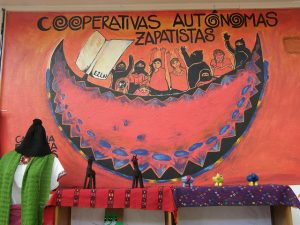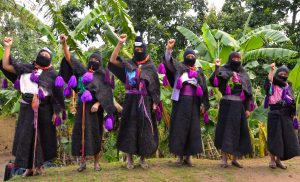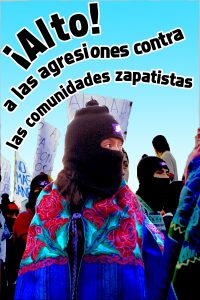Chapter Ten – Postmodern, Postcolonial Revolution
Notes on the Zapatistas
Zapatista: Peace with Dignity and Respect
For Everybody, Everything For Us, Nothing
January 1, 1994
- After 10 years of organizing underground, the Zapatistas took over several towns in Chiapas,, including San Cristobal de Las Casas, Ocosingo, Las Margaritas, Huixtán, Oschuc, Rancho Nuevo, Altamirano and Chanal.
- They liberated prisoners and set fire to police station and army garrisons
- The insurrection was scheduled for January 1, 1994, the day that the NAFTA (free) trade agreements came into effect
- Sent emails to almost every progressive activist in the world. Key to avoid heavier repression
January 2-12, 1994
- The National Army moves in with helicopters and heavy artillery
- The Zapatistas retreat to the jungle and suffer heavy loses
- Liberation Theology Bishop, Samuel Ruiz, negotiates a cease fire
- Zapatistas retain liberated land
1995
- The army breaks the cease fire and attacks the Zapatista villages
- Villages were abandoned and people moved into the jungle
- Military could not seize main leaders
- EZLN intensifies international campaign and starts organizing Encuentros in the Jungle (PGA)
2000
- Zapatistas implement 32 autonomous zones within Chiapas, with no government support and some international NGO support
- Zapatistas write The 6th Declaration of the Lacandon Jungle, calling for a broad global coalition, to the left and from the ground up
Chiapas in Context
- Largest indigenous population in Mexico
- High rates of congenital malnutrition, and infant and adult mortality
- High rate of illiteracy
- Life expectancy in indigenous communities 44 years (vs. National Average of 70)
- 159 babies die over 1,000 in Chiapas (vs. Mexico: 45/1000)
- Half of the population malnourished, girls more affected
Autonomist Movements Not Aimed at State Power
- The state abandoned indigenous people. In return, indigenous people abandoned the state
- Indigenous people created autonomous communities through self-governance and popular participation
- Lead by Obeying
- Slave/master challenged. Perspectivism upheld (long decision-making process with the whole community)
First Postmodern, Postcolonial Revolution
- Marxism meets the “overperson” (Nietzsche)
- Indigenous people hold a community-oriented subjectivity (identity)
- Result of the symbiosis of indigenous cultures and Postcultural Marxist praxis
- Post-structural Marxism is about “overdetermination” and diversity (adaptation of Marx)
- A diversity of ways of being in the world
Liberation Theology
- Bartolomé de Las Casas
- Liberation Theology
Zapatistas, Solidarity and the Economy: Surplus Value Stays in the Community

- Co-created the Anti-Corporate Globalization Movement
- Support of Western Activists against state repression
- Zapatista workshops outside of capitalist relations of production
- Support for the solidarity economy projects
Important Concepts
- Walking Questioning – answers reproduce power domination
- From the grass up and to the left
- Alliances with all oppressed by “bad government”
Women’s Revolutionary Law (1994) – Individual/Collective Tensions

- Women, regardless of their race, creed, color or political affiliation, have the right to participate in the revolutionary struggle in any way that their desire and capacity determine.
- Women have the right to work and receive a fair salary.
- Women have the right to decide the number of children they have and care for.
- Women have the right to participate in the matters of the community and hold office if they are free and democratically elected.
- Women and their children have the right to healthcare and nutrition.
- Women have the right to an education.
- Women have the right to choose their partner and are not obliged to enter into marriage.
- Women have the right to be free of violence from both relatives and strangers.
Juntas of Good Government: Chiapas Today
- Members of the government belong to the indigenous communities, campesinos, who toil the land
- They rotate every two weeks
- Men and women are part of it
- Established to diminish the EZLN army’s power and to better distribute and organize international aid
- They drink Coca-Cola (oh, no!)
- Still the object of aggressions by government agents and by paramilitary. A teacher was killed when defending a Zapatista school in 2014.

Part Eleven Video Lecture
“The Zapatista Uprising (20 Years Later)” by Vice.
Women Revolutionary Law
“EZLN Women Revolutionary Law” by thalisal
Media Attributions
- Cooperativa zapatista © Darij & Ana is licensed under a CC BY (Attribution) license
- Mujeres Zapatista © Visual Research is licensed under a CC BY-NC (Attribution NonCommercial) license
- Alto a las agresiones contra las comunidades zapatistas © Centro de Medios Libres is licensed under a CC BY-NC (Attribution NonCommercial) license

